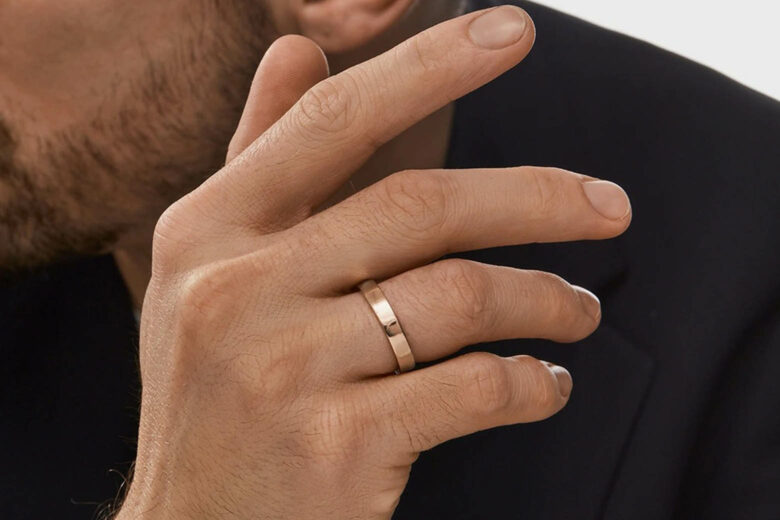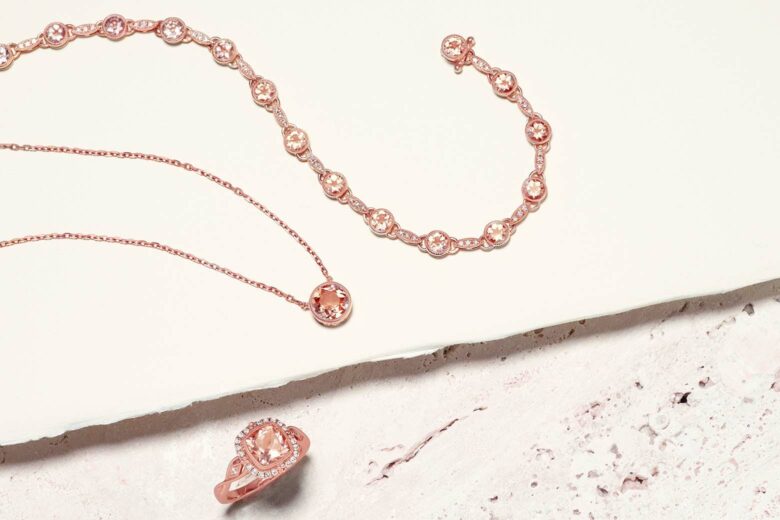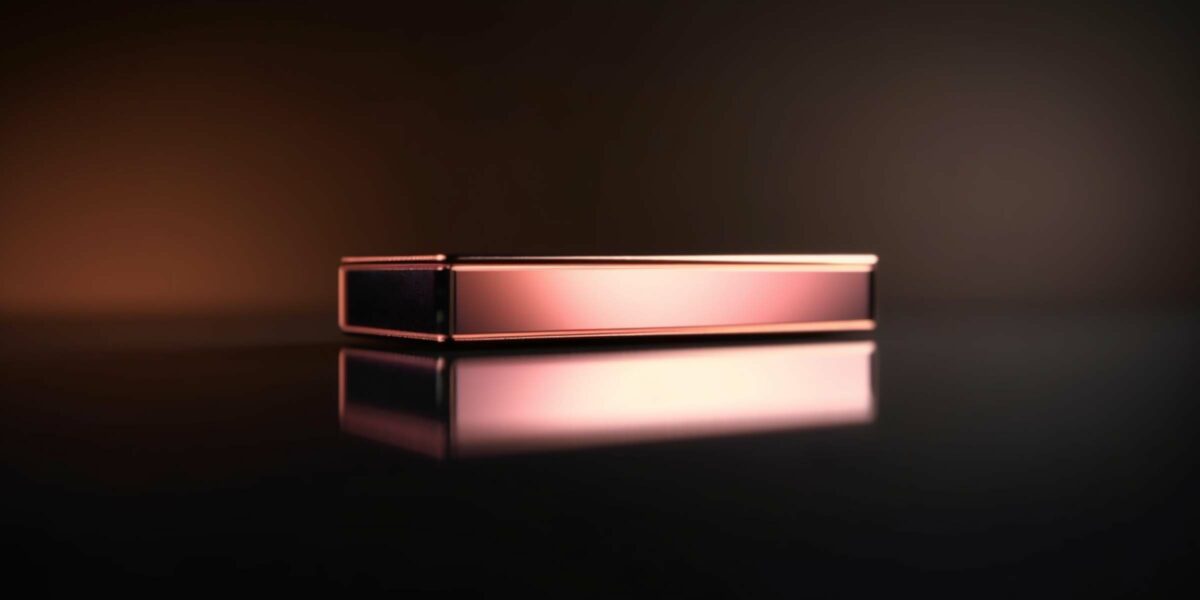Rose gold: the kind of gold that tickles us—and everyone else—pink. But while the romantic-sounding millennial-pink material might be loved the world over, most people know very little about the precious metal.
Hence, this guide to rose gold, a comprehensive deep dive into everything you need to know about the highly coveted metal. Is life in the rose (gold) garden as blissful as it seems, or is it all an illusion?
Conceptualized by Faberge in 19th century Russia, rose gold was later popularized during the Art Deco era for its versatility and offbeat hue. Still a favorite in fashionable circles today, rose gold is a masterclass in marrying together silvers and golds.
Whether it’s a delicate bracelet, statement ring, or heirloom necklace, rose gold jewelry pieces from our favorite jewelry brands deserve a spot amongst the other precious metals in your go-to jewelry organizer. And while you may think we’re looking through rose-tinted glasses, we simply can’t resist the ethereal charm of pink jewelry—especially when it’s also solid gold.

What is rose gold
Characterized by its warm, pinkish hue, rose gold is a combination of pure gold and copper, as well as other metals. The exact composition of rose gold can vary depending on the proportions of the different metals used, but it typically contains a higher percentage of copper than other gold alloys. This is what gives the precious metal its distinctive coloring, making it one of the most popular metals used in more contemporary jewelry.
Naturally, the depth of color of the pinkish hue in rose gold depends on the ratio of yellow gold to copper. A higher copper content will result in a richer rose color. While a higher pure gold content will result in a warmer shade of rose gold. An easy way to determine this is by looking at the karats. A 14K rose gold piece will contain more copper than an 18K rose gold piece, meaning that although it contains less pure gold, the rose gold hue will be more obvious.
Why rose gold? Well, besides the elegant romantic coloring, rose gold is extremely versatile. The complimentary shade pairs well with almost all skin tones. And as a failsafe jewelry choice, it can also be used to harmonize white and gold jewelry.
How rose gold is made
Rose gold is made by fusing pure gold with copper and sometimes silver or zinc. The process involves melting the gold and copper together until they are completely fused. The metal alloy is then poured into molds or rolled or forged to create a slim piece of metal that is easy to work with. Once the precious metal has been shaped, it is polished, finished, and worked into the desired form.
Although all rose gold contains pure gold, copper and sometimes zinc and silver, the ratio of pure gold to other metals varies from piece to piece; as does the ratio of copper to other metals. Not only does this impact the strength and durability of the jewelry piece, but different ratios of metals also produce different shades of rose gold.
For example, a 14K rose gold piece contains more copper than an 18K rose gold piece, giving it a deeper, redder hue. Some jewelers may choose to maintain this depth of color, while others prefer a lighter shade of pink and may soften it by adding silver or zinc to the copper beforehand.
Zinc is also often added to strengthen the alloy. Although copper is known for its resistance to rust and corrosion, it is one of the softer metals. Therefore, by combining the strength of copper with the durability of zinc, rose gold can be almost indestructible.
Is rose gold real gold?
If rose gold is made by combining gold with other metals, does that mean it isn’t real gold? Not quite. While “pure gold” refers to gold that is 100% gold and hasn’t been mixed with other metals, solid gold refers to gold that is consistent throughout, meaning that it hasn’t been plated onto another metal base. Because pure gold is considered too soft for everyday pieces, most solid gold jewelry—whether its yellow, white or rose—is actually “karat gold” or “alloyed gold”, which is pure gold mixed with other metals for strengthening.
So to answer the question of whether rose gold is real gold: Rose gold is indeed real gold.
Just like yellow gold or white gold, the karatage of gold jewelry reflects the ratio of pure gold to other metals. While pure gold is 24 karat, an 18 karat gold piece is 18 parts pure gold and 6 parts other metals and a 14 karat gold piece is 14 parts gold and 10 parts other metals. This means that 18 karat rose gold contains just as much pure gold as 18 karat yellow or white gold. It is just the other metals that are different, making solid rose gold jewelry just as valuable as any other solid gold piece.
Read our detailed guide to gold karats to learn more about pure gold and gold alloys.

History of rose gold
The history of rose gold can be traced back to the early 19th century in Russia, where it was first created by Carl Fabergé. Fabergé was a renowned jeweler, best known for his intricate and innovative artworks, commissioned by the Russian royal family—the most famous of which have to be the Fabergé eggs. Designed as Easter gifts for the wives and mothers of Russian Tsars, Alexander III and Nicholas III, Fabergé eggs showcase a unique pink-hued metal that became known as “Russian gold” or “pink gold”. Created by mixing gold and copper, the ethereal metal caught Europe’s attention and continued to grow in popularity throughout the 19th century.
Rose gold became increasingly fashionable in Europe, where it was used for various accessories, as well as to decorate affluent homes. In the 20th century, Cartier, the famous French jeweler, began using rose gold in many of its designs, making rose gold one of the most coveted metals across the globe.
Slightly unconventional yet totally versatile, the rose gold trend continued during the Art Deco period of the 1920s and 1930s. Recognized as the elusive sweet spot between gold and silver, rose gold became an easy choice, particularly in combination with expensive diamonds and other precious gemstones.
With the shift towards more understated, minimalist jewelry in the mid-20th century, yellow and white gold regained its popularity, while the demand for rose gold slightly subsided. This didn’t last very long and by the 21st century, rose gold was back in fashion. Adored for its warm, romantic hues, rose gold became especially sought after for engagement rings, wedding bands and other sentimental items. And as mixing metals became, not only acceptable but fashionable, rose gold became the vital middleman in trilogy rings and other on-trend accessories.
What types of jewelry can be made with rose gold?
As one of the most popular precious metals, rose gold can be used to make all kinds of quality gold jewelry. Since rose gold contains more copper than most gold alloys, it is less likely to cause an allergic reaction than other types of metal alloys that contain nickel or other allergenic metals. Considering this, rose gold is commonly used to design some of the best earrings for women.
Alloyed with a combination of copper, silver and zinc, rose gold is also one of the strongest and most durable metals. Water, scratch and corrosion resistant, rose gold is a failsafe choice for everyday pieces—including our best necklaces for women, as well as our best bracelets for women.
But it’s not just the precious metal’s durability that makes it an accessory hero. As the middle ground between gold and silver, rose gold is a masterclass in mixing and matching different metals. Looking to harmonize your yellow gold wedding band with a silver watch? Try a rose gold ring or bracelet. Can’t quite get your head around wearing white gold earrings with a yellow gold chain? Pop on a rose gold necklace to complete the trilogy. When it comes to wearability, the options are endless—so much so that you could say that the pinky gold hue is in the rose garden of versatile jewelry.

Does rose gold tarnish or fade?
With more copper than white or yellow gold, rose gold is less susceptible to tarnishing or fading.
However, it can develop a unique patina over time. A patina is a thin layer that forms on the surface of the metal. This is caused by the copper content in the alloy reacting with air, moisture and other environmental factors. The distinct patina found on rose gold ranges from light pink to a deeper red. And although it is considered beautiful by many, there are various techniques to remove a patina from solid gold jewelry.
How is this different from tarnishing? Tarnishing is a chemical reaction that occurs when certain metals come into contact with sulfur compounds in the air or skin. Unlike a patina, tarnishing is a lot less attractive as it causes the metal to darken or become dull. It is almost always undesirable and can be a lot more difficult to remove.
The fact that rose gold is less susceptible to tarnishing is one of the many reasons why it is so popular.
Check also our guides on the different types of yellow gold to learn more about what to expect when shopping for gold jewelry:
Are pink gold and rose gold the same?
Yep, pink gold and rose gold are the same thing. Both terms are used to describe the type of gold with a higher percentage of copper than other real gold jewelry, resulting in a warm, pinkish hue. The exact shade of pink depends on the ratio of gold to copper, as well as what other metals are present in the alloy. And according to the rose gold color code, the metal’s hue can range from a soft pink to a much deeper red.
While “rose gold” is more often used today, when the alloy was first created in the 19th century, it was commonly referred to as “Russian gold” or “pink gold”. Russian gold pointed to its origins, while pink gold described the unconventional hue of the metal alloy.
What color is rose gold?
Generally, rose gold jewelry has a distinctly pinkish hue. However, the exact shade of pink is determined by the ratio of gold to other metals. If the alloy has a high percentage of (yellow) gold, the rose gold color will be a lot more subtle and if it has a higher percentage of copper, the rose gold color will be a lot more obvious. But the ratio of gold to copper isn’t the only thing that will impact the rose gold color palette. Smaller percentages of other metals are also usually added to the alloy, each affecting the color of the precious metal in a unique way.
Silver is often added to rose gold to lighten the color and produce a softer shade of pink. Silver is usually added to an alloy with higher percentages of copper. Higher percentages of copper produce a deep pinkish, reddish brown hue. Therefore, the addition of silver is a great way to achieve an obvious shade of pink that is lighter and whiter. You can just think of it as having a similar effect to mixing white into a dark pink color palette.
Zinc is another metal that is commonly added to rose gold. And whilst its primary purpose is to strengthen the alloy, it can also be used to produce a more subtle, softer shade of pink. By adjusting the ratio of gold to copper, silver, or zinc, it is possible to create a diverse rose gold color palette, ranging from soft and subtle to bold and vibrant.
Following the popularity of the rose gold metal, the name “rose gold” is also now used to describe a soft, golden-tinged shade of pink. Used for anything—from wall paint to bathroom handles—the rose gold color code is #B76E79, RGB (183, 110, 121), and CMYK (0, 40, 30, 30).
The meaning of rose gold
“Rose gold” refers to the unique pinkish hue of the precious metal, which can, of course, have various symbolic meanings and interpretations. Like all things pink or red, rose gold goes hand and hand with romanticism. But it’s not just the shade of pink that gives off a tender sentiment. Rose gold was created by Carl Fabergé and since then has been associated with the famous Fabergé eggs, which were first commissioned for the wives of the Russian Tsars as romantic gifts. On top of all this, jewelry, in general, is representative of love—and so are roses—making rose gold jewelry the ultimate romantic gesture.
In the 19th and 20th centuries, rose gold was originally associated with femininity and elegance, but today it’s considered a unisex hue. As a popular choice for wedding and engagement rings, both men and women are embracing the versatile shade of pink with matching bands. Besides its connection to love and romance, rose gold also represents individuality and nonconformity. Although it is a sought-after metal today, when the metal alloy was first created, it was a movement against traditional gold jewelry. Considering buying yourself a rose gold piece as a mark of independence? You know what we think: go for it.
How to use rose gold
As one of the most elegant and versatile hues, rose gold is fantastic for tying everything together—from outfits to room decor. Commonly used for jewelry, rose gold is a go-to for those everyday pieces. From a rose gold watch to rose gold rings, you never have to worry about whether the subtle pink hue clashes with a particular gemstone or accessory. On that note, rose gold is also becoming more and more popular for everyday accessories. As the perfect way to add a touch of elegance to your ensemble without going over the top, rose gold handbags, shoes and belts are tres chic and on-trend.
Our interior secret: rose gold is just as good for pulling together rooms as it is for evening ensembles. Not only is the color effortlessly accommodating, but the warm hue is simultaneously inviting and sophisticated. Think of a rose gold frame above a teal velvet chair. Or imagine a rose gold vase on top of a clean white marble counter. Of course, rose gold bathroom accents are having a moment. And rose gold lighting fixtures are just as trendy. The overall effect? Warm and welcoming, but also unapologetically clean and contemporary.
Frequently asked questions about rose gold
Rose gold is just as real as any other solid gold jewelry. Because pure gold (24K gold) is often considered too delicate for everyday wear, most quality gold jewelry is made from karat gold. Karat gold is a combination of pure gold and other metals. Added to strengthen the alloy, the other metals can also impact the color of the gold. In the case of rose gold, more copper is added to give the alloy its pinkish hue.
Rose gold is just as expensive as any other solid gold jewelry of equal karatage. An 18K rose gold ring contains just as much pure gold as an 18K yellow or white gold ring. The only difference between the rose gold and other solid gold jewelry is the ratio of other metals added to pure gold. Rose gold contains more copper, giving it its pinkish hue. Read our in-depth guide to rose gold to learn more.
Rose gold is defined by its unique pinkish hue. However, the exact shade of pink depends on the ratio of gold to other metals. The more gold it has, the less obvious the pink. The more copper it has, the more obvious the pink. And the more silver and zinc, the lighter the pink. This means that the rose gold color palette ranges from a soft subtle shade of pink to a more vibrant and bold hue.
The biggest difference between gold and rose gold is what metals are added to the gold alloy. This impacts the strength and durability of the precious metal, as well as the aesthetic. The rose gold color is distinctively a pinkish hue, while pure gold or traditional solid gold is a vibrant shade of yellow.










